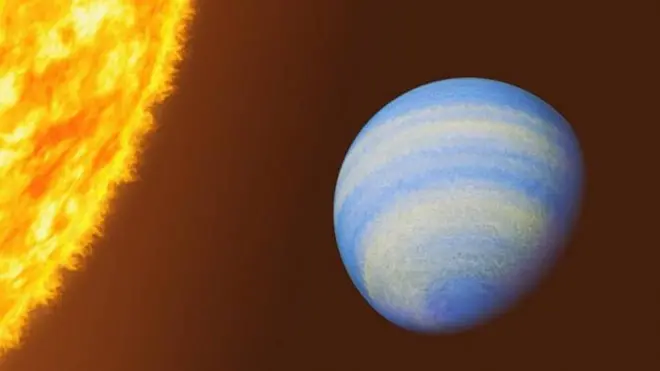Starting this Friday, February 21, the night sky will offer an impressive spectacle for astronomy lovers and curious minds alike: all the planets in the Solar System will be visible, seemingly “aligned,” creating a unique and fascinating sight. This rare and breathtaking phenomenon is an unmissable opportunity to witness the grandeur of the cosmos and gain a deeper understanding of the celestial bodies that make up our system.
Venus, Mars, Jupiter, and Saturn have already been lighting up the sky during the nights since last month. Now, Mercury joins this cosmic parade, completing the alignment. Although invisible to the naked eye, Uranus and Neptune are also part of this celestial spectacle, requiring specific equipment to be observed. This alignment creates a rare scenario in which all the planets can be seen simultaneously, providing a comprehensive view of our cosmic neighborhood.

The term “alignment” may give the impression that all the planets are organized in a perfect straight line around the Sun. However, what actually occurs is a celestial conjunction—a visual illusion created by Earth’s perspective. The planets continue their elliptical orbits in different planes and distances, but from our point of view, they appear to be positioned close to one another in the night sky.
Such phenomena are relatively rare and provide an excellent opportunity to observe multiple planets at once, without the need for sophisticated equipment, at least for the brighter ones. Furthermore, these events have a significant impact on popularizing astronomy, encouraging people of all ages to look at the sky and marvel at the complexities of the universe.
Throughout history, planetary alignments have sparked fascination and curiosity. Ancient civilizations, such as the Mayans, Egyptians, and Babylonians, recorded these events and often interpreted them as omens or divine signs. In some cultures, alignments were considered moments of great cosmic power, associated with spiritual changes or significant events on Earth.
In the modern era, these phenomena continue to intrigue scientists and amateur astronomers. The last visible alignment of all the planets occurred in 2004, and events like the one in February 2025 are highly anticipated by the astronomical community.
The ideal time to observe this phenomenon will be just after sunset. As darkness falls, the planets will begin to appear, each in a specific area of the sky:
- Venus will be the first to catch attention. Known as the “Morning Star” or “Vesper,” it will be the brightest point near the western horizon, easily recognizable by its intense brightness.
- Saturn will appear near Venus, but with a less intense brightness. Its rings can be seen with the help of a telescope, offering a spectacular view.
- Jupiter, the largest planet in the Solar System, will stand out higher in the sky, near the Taurus constellation, with an intense brightness that is easily identifiable. With a telescope, some of its larger moons, such as Io, Europa, Ganymede, and Callisto, can be observed.
- Mars, with its characteristic reddish color, will appear in the eastern direction, offering an interesting contrast to the other planets. On clear nights, it is possible to distinguish details on its surface using a telescope.
- Mercury, due to its proximity to the Sun, will be the hardest to spot. It will appear near the western horizon just after sunset but will quickly disappear as it follows its course.
For those seeking a more complete experience:
- Uranus can be located between Venus and Saturn. Although invisible to the naked eye, a good pair of binoculars will be enough to identify it as a small greenish dot.
- Neptune, the farthest planet, will require a telescope to be observed. It will be near Jupiter, but its faint brightness and bluish hue will demand specific equipment.
Tips for better observation:
- Choose a location with an unobstructed horizon, especially toward the west, to get a clear view of the planets closer to the horizon.
- Avoid urban areas with heavy light pollution, such as city centers. Remote or elevated areas are ideal.
- Use astronomy apps like Stellarium or SkySafari to locate the planets in real-time and identify nearby constellations.
- Bring binoculars or telescopes, especially if you want to observe Uranus and Neptune.
- Check the weather conditions. Clear skies and no clouds are essential for a good observation.
- Adapt your vision to the dark by avoiding bright lights for at least 15 minutes before observing to enhance your perception of celestial objects.
When is the best time to observe?
The last week of February will offer the ideal conditions to spot all the planets. With sunset around 6:30 p.m. (local time, depending on the region), twilight will provide the dark background necessary to highlight the planets’ brightness. The peak of the alignment will occur between February 24 and 28.
Fun facts about the phenomenon:
Complete alignments of all the planets are rare and may take decades to repeat.
Even though it is an optical illusion, these events generate great popular and scientific interest.
Ancient cultures considered planetary alignments as omens or mystical events.
In 1982, a nearly perfect alignment was studied by scientists to investigate potential combined gravitational effects of the planets.
In addition to their aesthetic appeal, planetary alignments have influenced various areas of culture and science. In astrology, these events are often associated with energetic changes and moments of introspection. In science, they provide unique opportunities to study gravitational interactions between celestial bodies and test astronomical theories.
Prepare your binoculars, apps, and, if possible, a telescope, and take advantage of this unique opportunity to connect with the cosmos. The February sky will be the stage for a spectacle that is unlikely to repeat anytime soon. Regardless of your level of astronomical knowledge, observing all the planets in the Solar System in the same celestial setting is an enriching and memorable experience, reminding us of the vastness and beauty of the universe.

